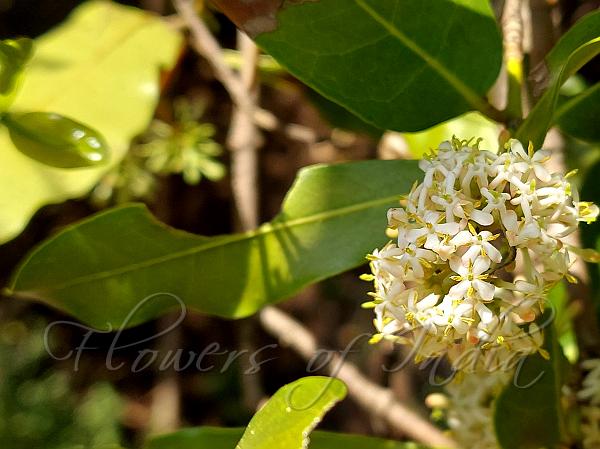|
| Torchwood Tree |
|

|

|
|
|
|
Photo: |
Botanical name: Ixora pavetta Family: Rubiaceae (Coffee family)
Synonyms: Ixora decipiens, Ixora arborea
Synonyms: Ixora decipiens, Ixora arborea
Torchwood Tree is a branched small tree, bark dark
coloured, rough, younger branches hairless. Leaves are oppositely
arranged, 7-15 x 3.5-6.5 cm, hairless, blunt or shortly pointed, stalk
5 mm long. Flowers are borne in corymb-like terminal panicle. Flowers
are stalkless, 5-6 mm long, fragrant, white. Calyx is minute, teeth
very small, obtuse. Flower-tube is threadlike, about 6 mm long,
hairless, petals 4, reflexed. Filaments are about 0.5 mm; anthers
equalling the corolla-lobes. Style is densely pubescent. exserted;
stigma biforked. Fruit globose, 2-seeded, somewhat didymous, black when
ripe. Very common on hills, deciduous slopes from 300-900m. India, Sri
Lanka, Bangladesh.
A small piece of the wood is placed on the stone during prayer when the
foundation stone for a house is being laid.
Cultivated in the gardens as an ornamental throughout the Indo-Pakistan
subcontinent. Flowering: March-April.
Medicinal uses: Flowers, pounded with milk, for
whooping cough. Bark: a decoction for anaemia and general debility.
Fruit and root, given to females when urine is highly coloured.
Flowers, pounded with milk, for
whooping cough. Bark: a decoction for anaemia and general debility.
Fruit and root, given to females when urine is highly coloured.
Medicinal uses:
 Flowers, pounded with milk, for
whooping cough. Bark: a decoction for anaemia and general debility.
Fruit and root, given to females when urine is highly coloured.
Flowers, pounded with milk, for
whooping cough. Bark: a decoction for anaemia and general debility.
Fruit and root, given to females when urine is highly coloured. | Identification credit: Radha Veach, Shrikant Ingalhalikar | Photographed in Maharashtra, Madhya Pradesh & Jharkhand. |
• Is this flower misidentified? If yes,